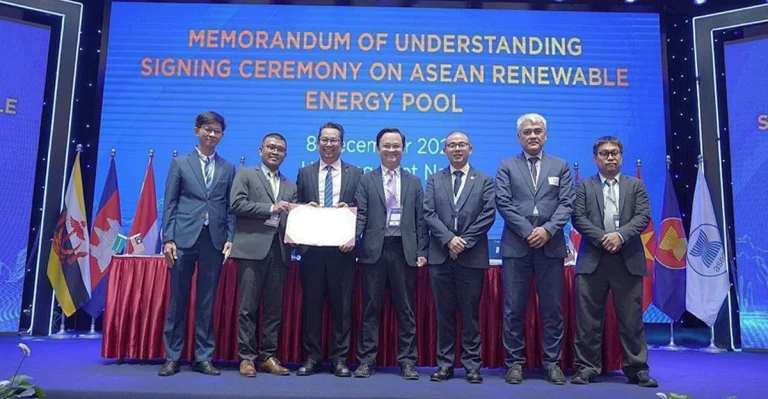How reinsurance pools could help shape Asia Pacific’s renewable energy future
Written by Blake Evans Pritchard


This (Re)in Asia Whitepaper investigates the potential for clean energy reinsurance pools throughout the Asia Pacific region. It was written with an editorial-first approach, however has been made available for you to read without a subscription thanks to our commercial partnership with Guy Carpenter.
Introduction
However, the challenges of pricing and managing risk in this sector are multifaceted: constantly evolving technology, shifting regulatory priorities and rising costs of natural catastrophe events.
As the technology that underpins renewable power sources grow more complex, the potential for insurance pools is sparking interest. The ASEAN Renewable Energy Pool was launched in 2023. There is the potential for something similar to be applied elsewhere in the Asia-Pacific (APAC) region, too.
This whitepaper explores that potential, with thanks to the vast range of experts who gave up their time to speak to me about the challenges and potential in a region as diverse as Asia Pacific.
Blake Evans-Pritchard
Editor, (Re)in Asia
Whitepaper navigation:
Key Findings
Shifting regulatory priorities in the renewable energy sector add complexity to insurance risk management, as insurers must continuously adapt to evolving standards and requirements. This dynamic environment underscores the need for robust underwriting expertise and flexible insurance solutions.
In December 2022, six reinsurers successfully launched a reinsurance pool in ASEAN to cover onshore wind farms, solar panels, and energy storage. The pool aims to centralise underwriting and claims management, enhancing (re)insurance capacity for renewable energy projects.
Sponsor foreword

The ASEAN Renewable Energy Pool, established last year, exemplifies how collaborative efforts can help address the unique challenges of insuring renewable energy projects, centralising expertise and ensuring capacity.
We hope this whitepaper provides valuable insights and encourages further discussion on the potential for adapting reinsurance pools across different APAC markets.
Together, we can drive the green transition and contribute to a sustainable future.
Tony Gallagher
CEO, Guy Carpenter Asia Pacific
A complex transition
As governments worldwide have accelerated efforts to transition away from fossil fuels, (re)insurers are eagerly exploring the possibilities that renewable energy presents.
However, pricing and managing this kind of insurance risk can be complex: technology is evolving, regulatory priorities are constantly changing and natural catastrophe risk is becoming harder to model as weather patterns shift. The problem is compounded by a shortage of underwriting expertise for renewable energy, especially in APAC.
“Energy transition is creating a complex risk landscape for insurers and operators. Today, insurers contend with evolving and often unproven technologies, multi-faceted projects, climate change, and gaps in risk knowledge and underwriting data,” says Michele Cibrario, Co-Head of Renewable Energy for Swiss Re.
He adds that insurers with the “capabilities to develop innovative solutions that meet renewable energy market needs will be well placed to capitalise on a significant opportunity”.
In 2022 the Swiss Re Institute estimated that by 2035 the world will have an additional 4.6 terawatts of renewable energy capacity, as long as countries deliver on their stated targets. This represents a compound annual growth rate of 7%, with 49% of that growth coming from APAC. Insurance premiums are also forecast to go up.
Such projections have sparked a great deal of excitement within industry.
“Because of this push towards renewable energy, there are a lot of (re)insurers entering the market, resulting in an increasingly competitive environment despite industry wide losses,” says Will Hiller, a Sydney-based Underwriter at GCube Insurance.
However, such enthusiasm could rapidly evaporate should significant claims start emerging.
In 2019, severe hailstorms in the US left insurers on the hook for more than US$70m in damages. This resulted in a sharp spike in premiums and prompted some insurers to tighten up their policy wordings about what constitutes a severe storm. Hiller thinks a similar scenario may play out in Australia.
“To date there has only been one major hail loss at a solar farm in Australia, so the market has been able to cope,” says Hiller. “However, with 8GW of utility-scale capacity now installed across the country, compared with only 325MW at the beginning of 2018, it is easy to envisage a scenario in which insurance capacity becomes strained with the inevitability of more catastrophic claims.”
He adds that many renewable energy projects in APAC are running on very tight margins, with limited money for purchasing expensive insurance policies.
Data from Munich Re shows how over the past four decades losses in Asia resulting from weather-related nat cat events have gradually increased.
Given the importance of the insurance industry in driving forwards APAC’s green transition, the industry needs to find a sustainable solution to retaining capacity in the market.
“Green transition is critical across APAC, and many countries are either at the beginning of or in the intermediate stage of their journey, and (re)insurance capacity is of high importance to ensure this journey continues,” says Arne Eisfeld, a Country Manager at loss adjuster Crawford, based in Singapore.
He says that each country should look at the problem differently, either relying on out-of-the-box solutions or more individually-tailored approach, depending on where the market is in its particular journey.
“There is not a ‘one-size-fits all’ approach, which in turn gives opportunities for specialty providers and alternative-risk-markets, alongside traditional markets,” says Eisfeld.










